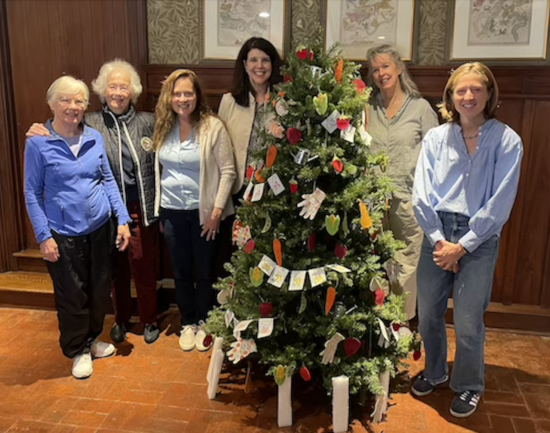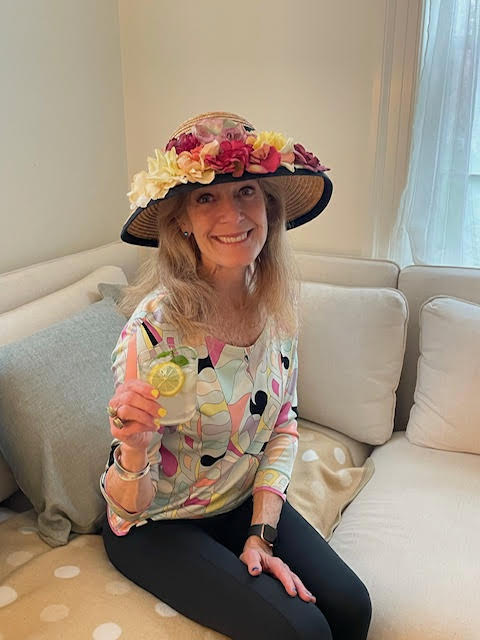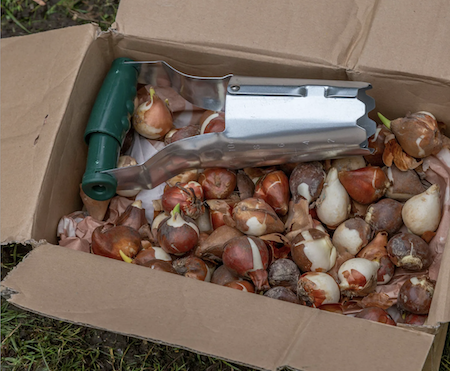November Newsletter
 A little Town Wreath design sneak peek! Sweet crocheted snowflakes by Pam Hixon
A little Town Wreath design sneak peek! Sweet crocheted snowflakes by Pam Hixon
November Speaker Program with Richard T. T. Forman
Discovering Concord’s Rocks & Stones: Outcrops, Glacial Legacies, Breaking/Splitting, Stone Wall Types/Ages
November 20, 1 pm at TriCon
Concord’s last glacier left huge rounded boulders, large-to-small stones, and sand almost everywhere. Early colonists made exhaustive use of these stones in becoming farmers in a novel land. The original stone walls in this early town spread from about the 1680s to 1770s and still bear their signature large stones visible along the base. These walls served two key roles: pasture walls mainly of a single row of stones mainly kept cows in pastures or out of crops and wetlands; cultivation or double walls, later filled with tiny rounded stones, also to keep livestock out of crop-fields and kitchen gardens. Later stone walls – built after 1880 – were more diversified, including berm-shaped mixed stones, machine-made walls, and a variety of designed-for-aesthetics walls. Professor Forman will share his enlightening research and images with us. You will never look at Concord’s stone walls the same way again.
Richard T. T. Forman, Harvard University PAEs Professor of Landscape Ecology Emeritus, received his B.S. at Haverford College, Ph.D. at the University of Pennsylvania, two honorary doctoral degrees in the U.S., and medals from the University of Florence and Charles University (Prague). He taught ecology at the Escuela Agricola Panamericana (Central America), University of Wisconsin, Rutgers University, and for 35 years at Harvard. His approximately 175 scientific articles and ten books helped pioneer the fields of landscape ecology, road ecology, urban ecology, and town ecology. He and Barbara Forman have lived on four continents, and have resided in Concord for almost 40 years. Here he wrote Mill Brook: Flowing through Time in1997, helped lead the 1996 and 2004 Open Space Plans, and the 1995 Historic Resources Masterplan. In 2001 with Delia Kaye and Robert White, he wrote Ecology of Concord Trails. Richard now works on the ecology of Concord.
It bears repeating that members wishing to bring guests to our meetings should first message the President, and also be prepared introduce their guest when called upon during opening business section of our meeting.
Important Dates:
December 2 – Wreaths installed at Town Offices around Concord
December 3 – Cans for Caring
December 5 – Holiday Workshop for Council on Aging
December 10 – Holiday Workshop for Members (see sign up)
December 11 – for Holiday Luncheon at the home of Julia Farwell-Clay from 11 to 1:30
Parking for Holiday Luncheon will be included in the December newsletter.
Family Trees at the Concord Museum

Monday of Thanksgiving week will bring installation day for the Garden Club’s Family Tree event team. Our book this year We are the Gardeners by Joanna Gaines and Julianna Swaney tells the story of a family garden, so we decided to plant a garden on our tree. This year’s ornaments include festoons of seed packets, appliquéed felt fruits, vegetables, tiny watering cans, silk flowers, a picket fence around the base, and a shower of tinsel “water” from a watering can tree topper. Recently, the talented team gathered for a dress rehearsal. Pictured above left to right: Liz Berk, Leslie Cheney, Barbara Kohler, Sharon Vinci, Julia Farwell-Clay, and Kelsey LeBuffe. Not pictured are Gail Barnett and Cathy Jenkins.
Welcome New Member, Leila Parke

After graduating from NYU as an accounting major, I worked in accounting for various companies in New York City and Boston for eight years. Over the years I have volunteered in prison, teaching a class in Financial Literacy as well as being a facilitator in the Alternatives to Violence program. I have lived in Concord for 23 years. I have four adult sons and three grandchildren.
Welcome New Member, Pamela Callahan

@GardenClubConcordMA
Our Instagram and Facebook pages could use a more robust following, especially from our own members! We are planning on a more consistent posting schedule, and would very much like to include the faces of the people we serve and our members engaged in the activities that make our club’s work such a positive a force in the larger community. Sally Savelle has also promised a “follow back” from any club member’s Instagram or Facebook account, so if you would give the Club’s pages a follow, we would be delighted to return the favor.
With that said, we will also be letting members know when photos are being taken for social media, and would like to keep track of any members who do not wish to participate in this way. Photos will never be tagged or names listed, and photos will be used sensitively. No weird angles allowed! Going forward, a list will be kept of members who wish to opt out, and everyone will be given this opportunity to chose during annual re-enrollment (when you pay your dues). In the meantime, if you so wish, let Rod Riedel know as he will be keeping track for the social media team. There will also be an opt out sign up sheet at the next few meetings.
Recommended Day Trip: Rory McEwen Show at Wellesley College
“The artist grew up on an 18th c Scottish estate, where he and his many brothers and sisters were directly exposed Dutch still lives and early French botanical illustration — with the original paintings at home. He began to make his own attempts, but then was sidetracked at Eton and Cambridge, when he became passionate about American jazz and Scottish folk music. So accomplished was he in those fields that he was on the Ed Sullivan show twice while touring the US and jammed frequently with the Beatles.
Of Interest

I found myself reassuring a gardening friend the week that it is not too late to plant her daffodils. In fact, the ground is now at optimal temperature for receiving your spring flower bulbs. As long as you can dig a hole, you can plant a bulb! I have even had success with throwing bulbs on top of the frozen ground in late December and covering them with a bag of soil. If you want to get fancy with your cultivation arsenal, here is a list of recommended planting tools from House & Garden, but any old spade will do!
Thank you to Dennis Fiori for sharing this article from the Royal Horticultural Society: Five myths of wildlife gardening, pitted against science
Are you feeding the birds this winter? There are so many conflicting messages coming at us these days, what is a friend of nature to do? Here’s a recent episode of Margaret Roach’s podcast A Way to Garden where she talks to *the* David Sibley about this issue.
